Anima: Beyond Fantasy by Ariamaki
| 1 | Introduction |
| 1.5 | Preview |
| 2 | First Five Pages |
| 3 | Revitalized |
| 4 | Basic Character Stuff |
| 5 | More Character Stuff |
| 6 | Races |
| 7 | Classes |
| 8 | Secondary Abilities |
| 9 | Dying and Running Away |
| 10 | Modules |
| 11 | Stuff |
Introduction
Original SA post
Well folks, I have good news and bad.
Good news is, we're here to discuss Anima, the Japanse-inspired Spanish-produced series translated (incompletely) into English!
Bad news is... We're here to discuss Anima: Beyond Fantasy, the RPG. As opposed to Anima: Shadow of Omega, the shockingly good one-box card game.
I'll give Shadow of Omega the praise it deserves in this intro (because Anima, as a franchise, is definitely good, and I give credit where it is due), and then we can dive headlong into Beyond Fantasy, which is also, conveniently, Beyond Sanity.
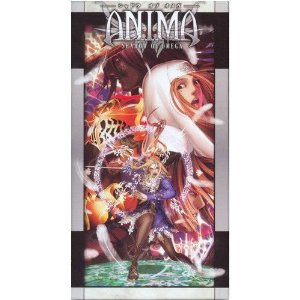
The best summary I have ever seen given to Shadow of Omega is "Competitive multiplayer JRPG". Each player controls an entire JRPG-style party, all of whom are vying to defeat the same main villain or threat-- Which is not always the same between games, being selected from a mini-deck. The gameplay is varied, fast-paced, and pretty well balanced, all considered. It is fairly cheap, extremely compact (stores well in the single box it came in), and easy enough to learn and set up in minutes.
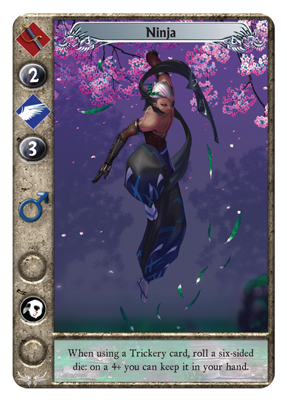
This is a single example party member-- A generic Ninja. The card follows the tradition of most Japanese-style card games, using symbols to mark different statistics-- In this case, 2 damage, 3 speed, and the mask means this can basically be used as Trickery "mana".
I won't get into details, since it is not the point, but suffice to say, the game is very good: If your Friendly Local Game Store happens to keep playable copies of board and card games for various occasions (Here's to you, Underhills) then drop in, get a four-man together, and try it out. It is definitely worth at least one play.
But this thread is not about good things, and we are traveling to a far less loving or kind realm...
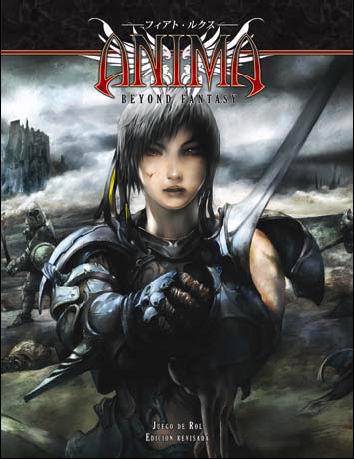
Anime: Beyond Fantasy is a pen and paper RPG that was developed in Spain in 2005, translated to English in 2008. It takes a very strange mix of Eastern and Western philosophies, settings, and myths, along with a totally insane system, and produced... Well, you'll see.
For those curious, the PDF version is for sale on DriveThruRPG, and the hard copy (which is huge, heavy, and amazingly well-printed) is not -too- hard to find.
But that's next time.
Preview
Original SA postaldantefax posted:
...
Aside from being incredibly opaque about a lot of things, magic is completely off the wall, damage scaling charts are almost worse than Rolemaster's, and if you're like me and tried to translate how to make a character into Excel just to calculate your shit it'll take about eight hours.
...
My experiences with the mechanics of the system, however, are less than positive!
You raise a number of VERY good points, all of which I'll cover in more detail when we get there, but let's take a quick dip...
1- "incredibly opaque about a lot of things"
This is putting it lightly. Anima goes out of its way to make sure that some things are as obtuse and hard to understand as physically possible. I dare somebody to find the actual function of a few of the summons or god-powers.
2- "magic is completely off the wall"
 WE ARE SORRY, BUT THIS GAME HAS FIVE SEPARATE MAGIC SYSTEMS. PLEASE BE MORE SPECIFIC.
WE ARE SORRY, BUT THIS GAME HAS FIVE SEPARATE MAGIC SYSTEMS. PLEASE BE MORE SPECIFIC.

OK, in all seriousness, ALL of them are completely off the wall, as my later example of play (I've got some things planned...) will demonstrate.
3- "damage scaling charts are almost worse than Rolemaster's"
From here on out, our good friend
 will represent the design staff of Anima.
will represent the design staff of Anima.
 -- "So, Rifts is well-known for having assloads of ridiculous charts? Let's beat them at their own game!"
-- "So, Rifts is well-known for having assloads of ridiculous charts? Let's beat them at their own game!"
I have literally used the damage-reduction charts to induce vomiting.
4- "and if you're like me and tried to translate how to make a character into Excel just to calculate your shit it'll take about eight hours."
YUP. Calculating things in Anima can and will induce retinal bleeding.
So folks, I guess that just leaves us with a preview of next time!
Anima: Beyond Fantasy posted:
Randomly generated point buy.
Anima: Beyond Fantasy posted:
Randomly generated point buy.
Anima: Beyond Fantasy posted:
Randomly generated point buy.
...

First Five Pages
Original SA postGeneral Ironicus posted:
I think FATAL may really have a skill for everything. I cannot imagine sitting around a table and being told to roll for silence.
Welcome to the thread! And if you're looking for wacky skills... Well, it gets a lot worse than Silence.
((Hey Syrg, can you put my previous bit into the first post as Part 1.5.- Preview?))
PART 2-- First Five Pages
Hoo boy.
OK, well, welcome to Anima: Beyond Fantasy, where our first issue is... organization.
Yeah, it seems mundane when we compare it to the other games in this thread, but the sheer DENSITY of it is painful. Let's just randomly flip through the first... five pages, say?
1 & 2 -- A table of contents. No biggy, although it does show that this 300 page game is broken into... TWENTY-SEVEN CHAPTERS?
...OK, going to move past that.
3 & 4 -- In one extremely quick blast, we get the "What is an RPG" summary, the needed OOC equipment, the GM notes, and... The example of play???
(double checks)
OK, yeah, the Example of Play in Anima? It's not even a full page of text. And involves characters named Lemures, Pazusu, and Celia. We will be rectifying this.
Also, we immediately jump into the game mechanics, including the Open Roll concept, which is like taking the worst parts of exploding dice and critical hits and forcing them to crossbreed.
Basically, an Open Roll triggers any time you roll a d100 (frequently) and get 90 or better (1 in 10, not counting abilities that fudge and manipulate the dice). You then roll ANOTHER d100 and add it. If you got 91 or better? Do it again. Did that get 92 or better? Do it YET again. And so on. And 100 is always Open.
Every single ability check in the game is d100 based, higher is better.
Oh, and just to be a dick? When you roll single d10s, a Characteristic Check? Lower is better.
5-- ...The Fumble chart, the Mastery summation, Ability, Resistance, and Characteristic Checks, and something called the Rule of 10 and 1 (a totally separate Open-Fumble equivelant for d10 rolls), and the System conclusion (???). That's page 5 ALONE. They really try to pack the critical info into this sucker, front-loading and over-dense as all get out.
Oh, by the way? d100s fumble on 1-3 . And when you Fumble, you get to roll another d100 to find out how BADLY you Fumble. Yes, really.
The various Checks are... somewhat logical, no big beef yet, although I will note that if an Ability hits 200, you get Mastery, which knocks a level off the Fumble chart.
Now, you may ask why I picked five pages.
That's because Page 6 is an art splash and Page 7 starts Character Creation. Yeah, there are 27 chapters in a 300 page book because chapters are TINY.
So next time, on Anima: Beyond Fantasy...
To be born is to begin to die.
--Theophite Guatier
((Actually Anima, hate to break it to you, my sources say a critical review of Waiting for Godot beat you to that punch.))
CHARACTER CREATION
Revitalized
Original SA post Anima: Beyond Fantasy , part 3: RevitalizedI'm going to pick up and run with this, starting from where Ariamaki left off. However, also like Ariamaki, before I try to dig into the actual ruleset, I think I need to share a bit of a story. My experience with the Anima line has been a goofy one. My first exposure came from seeing Wen-M 's art, which I found fascinating. Finding out that it was art for Anima, I couldn't wait to get my hands on the RPG. How could anything that looked so cool be anything but great?
You'd have thought I would have learned my lesson from Exalted.
I have a confession to make: I have no idea how the hell to play Anima. I've read through the core rulebook twice, and I have no idea of how to play. I'm taking a third stab via taking notes, but I'm trying to learn as I go, here. There's enough weirdness that I think that this should still be interesting, but I may end up getting rules wrong as I go, because I think Anima was written all at once.
I don't think it was drafted and edited and playtested. I mean I think that the whole ruleset suddenly struck someone as he woke up from a fever dream, and it just took 300 pages to write down this one idea. The game at no point shies from namedropping rules from a much later chapter, without mentioning where they can be found or anything. It seems like divine inspiration to grasp the whole of the RPG all at once is about the best method to get it, but failing that I'll see if we can't pick it apart enough to try to learn in a linear fashion.
Because, after it all, what I know of Anima, I still like . There are a lot of charming little flourishes in here that I'd love to show off.
Where Ariamaki left off in the rules was page 5. Right about here we get the basic systems of Anima. Anima runs on two basic rolls: d10, and d%. d10 rolls are based on Attributes (D&D term: ability scores), and the idea is to roll less than your Attribute. If you're in an opposed roll, you try to beat your Attribute by more than your opponent did his. Seem simple enough?
Here's the rub: If one players' Characteristic is more than 4 higher than the other, you get an effective boost. So if I have a 3 in an attribute, my enemy gets a boost of two for 8 and above: 8 is effectively 9, 9 is effectively 11, 10 is effectively 13. In this way, it's quickly impossible to defeat something significantly your better.
The other weird rule to subvert that. Rolling a 10 is treated as a 13, and rolling a 1 is treated as a -2. There's always a chance for an extreme edge case (and, oddly, no possible way to roll a -1/0/1 or 10/11/12 on a d10).
This is another of Anima's weird flaws: take a mechanic, then toss on fringe-case rules until player is confused.
Anyway, the other roll you can make is a d100, which is for this game's equivalent of skills and attack rolls and so on. With this, if you roll a 1/2/3, you fumble and roll again to see just how badly you screwed up, but on the other side of things if you roll 90 or better you roll again and add the results. You can keep doing this with the minimum roll needed going up each time (91, 92, 93...), but statistically this eventually isn't gonna matter much. This way, there's always a chance that even the lowliest contender will execute a single, beautiful moment in anything. Naturally, there's also an extra rule for the super-talented that lowers the chance and significance of fumbling. Which is nice, I suppose.
d% is also used for your 'saving throws' (Resistance checks to Anima), but you can't fumble or open roll it. Just one single dice toss.
So that's the basis of Anima: d10, d%, and collection of fiddly rules on top of that to try to keep the competent generally invincible while allowing the possibility at any moment that any single roll by the disadvantaged will utterly turn the tables.
Next time we'll start actually digging into what a character actually is in Anima.
Basic Character Stuff
Original SA post Anima: Beyond Fantasy , part 4: Basic Character StuffLast time we learned that Anima runs on alternately a roll-under d10 and a roll-high d% resolution system, in different situations.
We of course have our Characteristics (in D&D: ability scores) as the basis for our character: strength, agility, dexterity, constitution, intelligence, power, willpower, and perception.
Agility and dexterity I'm not sure why they split up; together they determine reaction speed. Power seems to be charisma and ability to resist the supernatural while willpower is how determined you are and helps with psychic disciplines instead of the supernatural. Have I mentioned Anima has somewhere around five magic systems?
Just in case this wasn't crying "D&D! D&D!" at you loud enough, we talk about rolling for our Characteristics now. 1d7+3 for each, 2d10 for each drop lowest, 1d10 for each, or rolling 7d10 as a pool to split between Characteristics 1-for-1. 5 is human normal, 10 is human max, 11-20 is in the realm of the supernatural and it suggests not allowing PCs their full benefit, like perhaps someone with 11 str still having the carrying capacity of 10.
Something Anima tries, which it doesn't do perfectly but I appreciate anyway, is making it possible to get stupendously superhuman, but it takes some serious effort to get there. So I'm not really gonna bitch about that one.
Since the book was laid out by a madman, it will be quite a while before we look at what these physical characteristics actually allow.
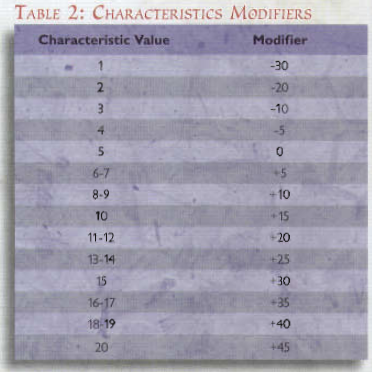
Of course there's a table for ability modifiers
Secondary characteristics: appearance and size. Appearance just says "roll for it or let people pick, who cares". Size is where things get loopy. Str + Con gives us a table for our height and weight.
Recall that with a lot of their rolling systems, these characteristics could be... low. Or high.
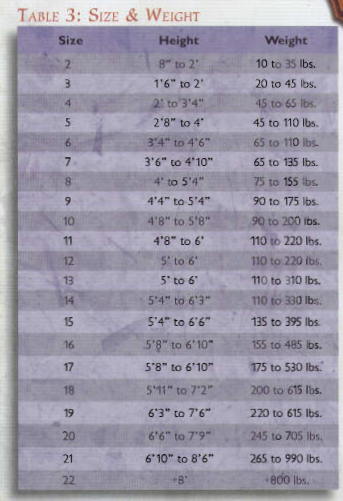
I guess the classic D&D type wizards are best off being three feet tall
We now get several pages of the primary and secondary abilities--this is skills, base attack bonus, magical talents, weapon proficiencies, etc. Basically none of these are going to make sense without context (Zeon? Magical Accumulation? Psychic Projection? Mystical Modules?), so we'll skip that until the book gives in and explains it.
Classes are listed and then mention is made that they're in their own chapter. So we'll look at what a Domine and a Novel are some other day. This isn't so much a chapter on character creation as an outline for the next few chapters, really.
Now we actually get to a few solid numbers and their use: "development points" are how you build your character; you get 600 DP at level 1 and a smaller amount each level. You use these to buy your skills and class features. To help keep things balanced out, though, you can only put a certain amount (usually maxing out at 50 or 60 per cent) of your DP in a specific area like combat or magic. This discourages straight-up maxing everything and lets you spread things out a bit more so you don't have to ruin your concept to keep up with Stabby Jones, who wants to pour everything into solely fighting.
Anima wouldn't be Anima if it didn't have an extra rule for pointless complexity, though: after you spend your DP for a level, you can increase a chosen secondary ability (in D&D: skills) by another extra amount.
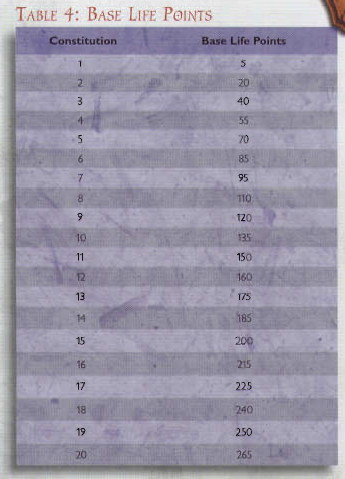
Anima hates to have any consistency in how it increases its tables--5 base, +15, +20, +15?
Life Points are HP. Presence is DP/20, and is a bonus for all your saving throws as you go up in level. Resistances are for disease/magic/physical/venom/psychic, and give a bonus to that type based on your characteristics.
Mostly pretty together, right? Of course not! Next time we'll confuse the issue by mixing CP in with the DP, explaining level zero and Anima's oddball class changing system, and then having an example of character creation before we get to three quarters of the rules on actually making your character.
More Character Stuff
Original SA post Anima: Beyond Fantasy , part 5: More Character StuffLast time we scratched the surface of what Anima characters look like. To the DP "Development Points" we add CP "Creation Points". Which can probably only be used at character creation. In contrast to the 600 DP we get, we can take up to 3 CP. Or possibly 6. It says we can take up to 3 of the positive stuff, then 3 of the negative stuff, and it has to balance out, but I could read this as balancing out at either 3 or 0 CP.
I'd think it was max of three, balance of zero, except that we have things like "change an attribute to nine" that costs 2 and can be taken multiple times. Flipping ahead to the character creation example... yeah, it's a balance of 3. You have to look at the character creation example to figure out the rules.
So what the hell, man.
Anyway, it's the same list of advantages and disadvantages you've all seen before. Acute senses, animal affinity, night vision, and... experience point bonuses.

I don't think these are all exactly well balanced against each other, honestly.
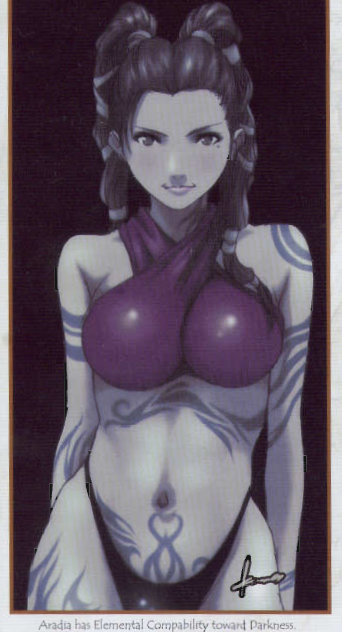
Pictured: totally not someone's PC and actually a good example, I'm sure
Disadvantages range from losing a bit of attractiveness and sleeping deeply through an addiction to having no vision.
There's also a few that add flavor restrictions to your magic and psychic powers. Those are cool.
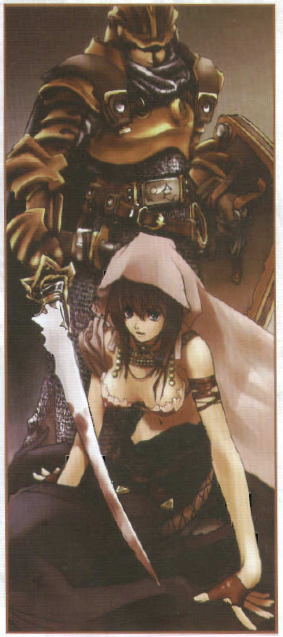
Pictured: a good example of.... psychic disadvantages? I guess getting your head chopped off is bad for using psychic powers.
Want to change class in Anima? Sure, no problem! You can do that in... two levels. Yeah, before you can do any sort of retraining, you need to grind two more levels, then spend the DP that are your primary advancements at anything and everything to do so. This mostly isn't worth bothering with, except when it is. I'll get to that when we look at the classes; one archetype is practically begging to use this.
Want to be level 0? Well, actually, it's more like level 0.67. You get 2/3 of your level 1 bonuses, and work towards gaining the total of 0 XP needed to hit level 1. It seems to be for 'getting started' stories, but I don't know why level 0 is preferable to level 1 there.
The chapter wraps up with a character creation example that doesn't make any sense because we haven't actually gotten to half of its content. Maybe we'll come back to this once we at least know what a class is in Anima.
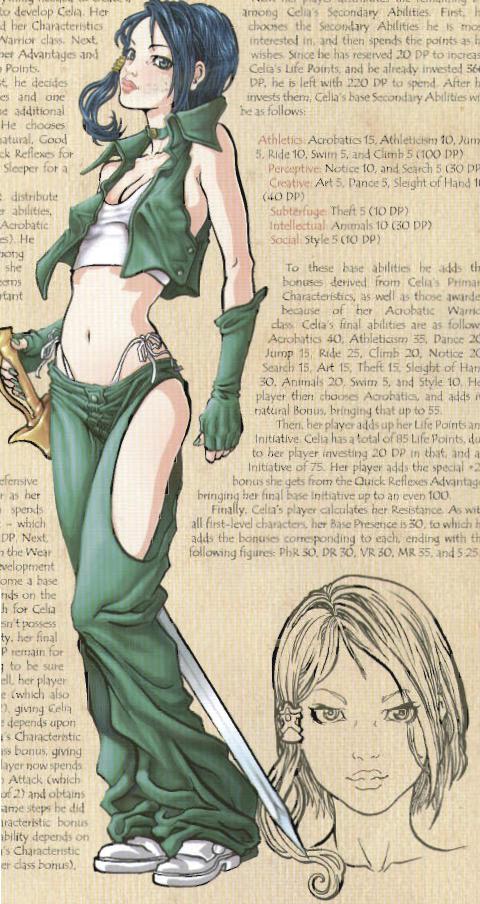
Also, this is our example character. Yes, she's a warrior. Yes, she has the Wear Armor skill.
Next time: Otherkin!
Races
Original SA post Anima: Beyond Fantasy , part 6: RacesSo Anima is mostly about humans... but you wanna play a non-human, huh? Fine. In Anima's setting there's no other races. Not any more. They're all dead. But they left behind their souls, which sometimes get reborn as human. So... otherkin?
They take on the appearance and mannerisms of their true soul, despite being born to human parents. They are honest-to-god Otherkin, with mechanical benefit for being so.
They get various powers in addition to the normal human array, and in exchange they gain -2 to -5 experience points whenever XP is handed out. Yeah, if you deviate from the recommended amounts of experience gained? Your races fall out of balance whack. Assuming they were ever in. I couldn't even guess.
Anyway, Sylvain: elves. Not foresty elves, no sirree. These are the haughty high elves, who don't have to go outside. They get magical bonuses for light magic, heal quickly, and don't need as much food or sleep.
Jayan: giants. They're big, tough, strong... you know the drill. Except they can see ghosts with their third eye. Okay, that was random.
D'anjayni: fae or ghosts or something? Hard to remember, hard to track, hard to eavesdrop on. Perfect for that one asshole who's desperate to play but can't conceive of a character who doesn't use high stealth to hide from the group and never talks to anyone.
Ebudan: angels. What the hell are these names from? Just gibberish to have more 'fantasy' names? These guys have a destiny and most of their powers (like wings and being immune to normal damage) don't kick in until after they achieve it. Bad for a game, isn't it?
Duk'zarist: Drow. Basically Sylvain flipped upside down, with an extra helping of red creepy eyes and angst.
Daimah: catgirls. What, you didn't think we were going to miss that one, did you? They love to dress up in outfits that remind them of their favorite animals and act like cats a lot and what the hell, you've probably all seen them in an anime sometime, or at least had a weird classmate who liked such enough to dress up. They're furry otherkin.
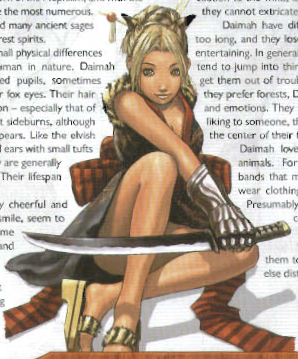
Anima, I want to like you so much, but you don't make it easy.
Next time: classes.
Classes
Original SA post Anima: Beyond Fantasy , part 7: ClassesOkay, classes. For once, this is a pretty sane thing. Classes determine your aptitudes, basically. Every level up, you get certain things free, and then get to distribute your freshly-gained DP. What your class does is determine the cost to raise things, and how much can go into what categories--for instance, a warrior might be able to put up to 60% of his points into his physical combat stuff, while a psychic can put less. Lower numbers are better, of course. "+1 Attack: 2", like for a warrior, means that for 2 DP your attack goes up one. "+1 Attack: 3" means it costs 50% more per point. It offends my sense of neatness that higher numbers are worse here, but once they're on your sheet, higher is better. Other than that, great.
Every class has costs for every stat in the game. That's it, that's how they work. Even if you can't find a class that exactly suits your ideal balance, you can get really close just by noticing that you're not required to raise any particular stat as any particular class, and they all have their automatic stat ups to prevent dumb snowflakes like a weaponsmaster who doesn't know which end of a dagger is sharp.
We're done! I'll see you next time.
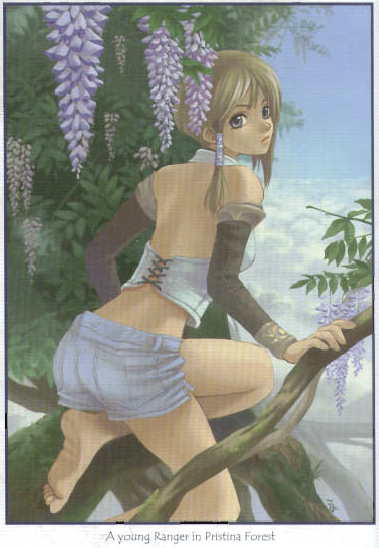
Pictured: proper dress and make-up for long trips through untamed jungle.
You're still here?
Yeah, okay, I suppose there is more dumb edge cases. That is the soul of Anima, after all.
See, the physical classes get their automatic stat increases to things like Attack, Block, and Dodge. These get capped. They're the only things that get capped. So level 11? Your warrior starts getting way less stuff than other classes.
So if you're a warrior or weaponsmaster or the like, once you hit level 9 you announce that you want to change class to something that doesn't cheat you of your bonuses. It has to be 9, since it takes two levels to change classes.
And the Freelancer class is the best choice to go to, obviously. We've all played Final Fantasy V, after all.
Everyone else gets their best bonuses by just sticking to their starting class, it looks.
Now that's about it. There's nothing more of note here. The classes are individually not particularly distinguished, and include silly half-way things like Wizard Mentalist, Warrior Summoner, and Illusionist (half thief, half wizard). Easy to do anything that Anima's system allows with this class system.
Next time: Secondary Abilities. We haven't seen primary abilities yet. Look, I didn't lay out this book, I'm just trying to make sense of it.
Secondary Abilities
Original SA post Anima: Beyond Fantasy, part 8 : Secondary AbilitiesSecondary abilities? In any other game, this would be 'skills', so I'm mostly going to use that term. There's seven categories of skills, with quite a few items in each heading. The headings are important; classes get a cost for raising skills by category. Anima being Anima, there's also reduced costs for some specific skills for some classes. For example, an Illusionist has to pay 2 DP per point in a social skill, unless that skill is Persuasion. They get a reduced cost that gives them skill points 1:1.
If you recall, Anima uses exploding dice d% for most checks. So, the difficulty chart for things starts with Routine (DC 20) and scales up. the highest level of success that a PC can normally achieve is the eighth highest at Impossible (DC 280). The level nine and ten DCs are marked as Inhuman (320) and Zen (440). You need a special feature that says you can do these sorts of things before you can achieve it. I think this just means that even exploding dice cap out, but it's not really very clear.
Opposed checks are quite sane: roll and whoever gets highest wins. Except, no, there's nothing on what happens if someone achieves an Inhuman/Zen result but doesn't have the ability to, and sometimes you need to beat your opponent by a certain number--like Spot beating Hide by 80 for a standing-still person or you don't see them, in the given example.
Okaaaay.
Anyway, there's 38 skills in the seven categories, from obvious standbys like picking locks and persuasion all the way to Composure (stay cool when something upsetting happens) and Style (makes sure that your scars look rakish instead of horrifying). Honestly the list could probably stand to be pared down a bit, but with the bonuses you get to all this stuff, you can afford to fling a few points for flavor or fun. I'm pretty fond of it.
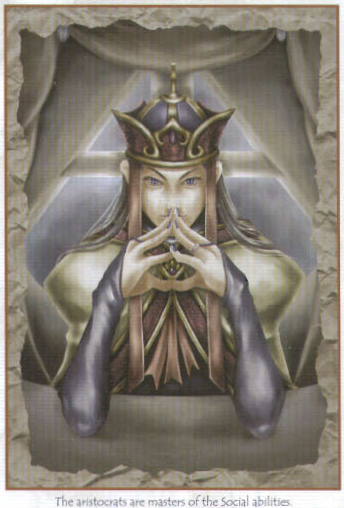
I call it... The Aristocrats!
Now we go into making stuff. Yeah, "Creative" skills includes stuff like Forging, so we have to know how to do that. Let's see: the main check is just a Forging roll. Fair enough. If you get a result two ranks above the minimum, your creation gets a +5 bonus, and so on for up to +15. What does this +number do? Beats the hell out of me, but I think I recall seeing it gone over in the equipment section. Naturally, there's not even a hint of that here, much less a cross-reference.
Special materials the next page over... they all have difficulty adjustments, max quality, and availability. Difficulty is probably the only one not self-explanatory. Seems that Difficulty is straight applied to your roll. So if you can make something mildly tolerable out of Stone (-80), you can make a wonder if someone supplies you with Elektra (+20). There's several special materials that just look awful to try to use. White Steel of Shivat has a nice max Quality of +10, but the roll to use it is -40. Elektra also caps out at +10, and while a little rarer is thus strictly, absolutely better for everything in actual use. The one time the system doesn't get fiddly with its exceptions is that all materials are all equally viable for all things, whether you're making your "studded leather", a frying pan, or a Two-Bladed Katana (at least one creator has a serious love for this weapon--more on this later). You can make any out of wood or starmetal, and the starmetal is better and easier for all of them. Also all things are made out of only one material. Studded leather? Made wholly of wood.
Next time we'll learn how to die and do things physically. Yeah, death and healing comes before combat. Kind of unusual, but not actually a problem.
Dying and Running Away
Original SA post Anima: Beyond Fantasy, part 9 : Dying and Running AwayWe've got two short chapters here, wedged into four pages between skills and... proficiencies and martial arts, aka, both things you know. I... can't figure out why they thought this was the best way to do it, but okay. Today we'll see what happens when you get hurt, and next time we'll look at how to know if you know how to hurt something.
In Anima, HP are called "LP", for Life Points. We get a nice little explanation about how HP aren't a direct representation of actual damage-soaking ability (example being that a 130 blow on someone with 90 LP could smash a rib cage, but it doesn't on a guy with 240), which I definitely like.
When your LP go negative, you're unconscious and dying. At -(5 * Con score), you're dead.
Anima's weird extra rule that needs to be accounted for in this chapter? Critical hits. After a critical hit, you lose one LP/minute and suffer penalties that accrue every five minutes until you get that looked at or the GM rules it healed. I... think that combats are going to be quick enough that there's no reason you can't patch yourself up before this ever comes into play.
We also get a big ol' chart that details our healing rate, based on our Constitution. At 1, you heal 10 LP per day of rest, or 5 per normal day. At 11, the highest you can achieve at level 1 (I think?), you heal 2 per minute.
Doesn't scale by your actual LP totals or anything, so tougher people take longer to heal still, but other than that, it's pretty cool. It even has notes on things like what level you don't get scars any more (5), when you start being able to reattach severed limbs just by holding them to the stump (7), and just plain ol' regrowing them (11). Keep in mind, up to 10 is considered within normal human limits.
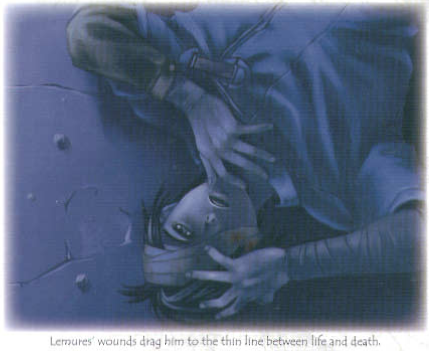
Only art here is of one of Anima's iconics dying.
Physical abilities! Let's see... movement is expressed in per-three-second-round, and given in feet. It's based on agility. So an Agility of only four gives you 50 feet per three seconds, or a hundred yard dash in six seconds, shaving three seconds off the world record.
Okaaaay... I guess that people in Anima are really fast . Nice change from many of these other games. The fastest you can get without having to be Inhuman is 115 feet per 3 seconds, or a hundred yard dash in about 2.6 seconds. When your movement rate is up near max, you can run 15 miles in 3 seconds (19 out of 20 possible) or just "wherever you want to be this moment" at 20.
You can jump 1/5 of your movement rate. Sweet jiminy, I can jump 20 feet vertically with a good running start?
 I'm very fond of games that let PCs be mobile.
I'm very fond of games that let PCs be mobile.
Lifting weights... eh, nothing too wild.
You need to eat and sleep... nothing else wild here.
You also get Fatigue Points based on your Constitution that basically act as action points--wear yourself out for a bonus on rolls. Use too many and you start suffering penalties because you're tired. Well, we wouldn't want too much of an incentive to use these, now would we?
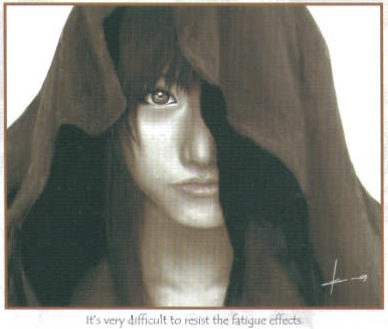
Must make justifying caption...
Next time: something we wish was as straightforward as proficiency.
Modules
Original SA post Anima: Beyond Fantasy, part 10 : ModulesMake up your own excuse for me. I don't have a good one.
Anyway, modules. What's a module? It's D&D's proficiency, seen through the eyes of someone who thinks that it's not reasonable for someone to know how to use a spear, but not a guisarme-glaive, though he should still be able to use that better than a two-bladed katana.
You buy modules like "Barbarian" or "Knight", and learn to use a list of specific weapons. You get lesser penalties for a weapon that you don't know, but is in a weapon group that has a weapon you do know. Costs are also lowered to fully learn such weapons and c'mon man. It's not worth it to track this like this.
Past the proficiency stuff, it gets more complex. Next up is "Style" modules. You can buy stuff like a quickdraw-equivalent, or a bonus for disarming foes. Okaaay.
Then we get into Psychic and Mystical modules. I cannot parse these. I'm completely baffled.
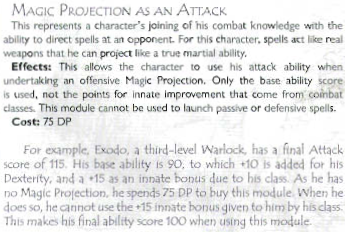
No, really. Help me out?
Martial arts is next! Unlike weapons, which have a total of four modules which change up your options, each martial art gives some advantage or other, many have requirements before you can purchase them, they give a bonus to "Martial Knowledge" (another term we haven't heart yet!
 I was almost thinking we'd seen every important term, but we're only 60 pages in), and bonuses to stuff like blocking or attacking. None can be used while you hold any sort of weapon. So if you've got a knife in your hand, sometimes this lowers your initiative hugely.
I was almost thinking we'd seen every important term, but we're only 60 pages in), and bonuses to stuff like blocking or attacking. None can be used while you hold any sort of weapon. So if you've got a knife in your hand, sometimes this lowers your initiative hugely.
The 11 listed basic martial arts are all real, though the selection is slightly odd--we get two types of karate split apart, but all kung fu is just 'kung fu', and there's some omissions I'd've expected to see. I'm not feeling spergy enough to go over that with a fine-toothed comb; it's a decent list.
Then we get to advanced martial arts! These are the anime things, like a super women-only martial art that lets them counter attack without ever appearing to move.
(Paranoia
 for girl with no clothes but not really showing much more than a bathing suit would)
for girl with no clothes but not really showing much more than a bathing suit would)
I, uh... I... um...
No kamehamehas, though; that's the realm of the magic systems. We'll get there, eventually. Next up is equipment, then combat. We're really working towards combat, because... well, you'll see.
Stuff
Original SA post Anima: Beyond Fantasy, part 11 : StuffWeapons, armor, miscellaneous equipment, all that good stuff--this is the chapter for that.
We start with money. There's three denominations of coin: copper coin, silver coin (10 CC), and gold coin (1000 cc). How much money do you get to start? Well, it depends on your social class in the world. If you're a mendicant with no income, you start with 5 cc. If you're minor nobility, you start with 150,000 cc. Shouldn't be a problem if one character has thirty thousand times as much money as another for their first adventure, right?
Well, to be fair, I'm fishing for trouble there. Although it does allow for a d10 roll for randomly deciding your social class, it recommends basing it on backstory, and it shouldn't take a genius to realize that putting people on similar strata is a good idea.
Items can be common, uncommon (only in large cities and specialty areas), or rare (GM whim).
Equipment! Charts of stuff, ranging from a small boat (20 gc) to a warship (15,000 gc) for all sorts of stuff. Our destitute starting character can afford either one poor meal or a pair of mediocre whitey-tighties (but not both), while the rich kid can buy a couple of full, well-made outfits for a percent or two of his starting money, and meals are roughly a rounding error.
Weapons range in price from 0.2 gc (scythe, lasso) up through the writer's favorite of double-bladed katana for 75 gc.
After the charts, we get notice that well-made items can be +5, +10, etc, up to a maximum of +25. Recalling that this is a d% system instead of d20... those numbers look awfully familiar. They get a list of bonuses per +5, including to things like Presence, which so far has solely been for saving throws. Why is it called Presence? Beats me. Maybe we'll find out later.
We're told damage types (including damage types that no normal weapon can inflict, like Energy) next, mentions of the types of weapons (weapon groups, except in the Anima charts they're all in a jumbled mess...
Now we talk about weapon damage and speed. Flipping back to the chart to see if they're listed there... nnnnnope. We have to flip ahead. Yeah, there's two charts for weapons: one for buying, one for their combat stats. We needed to make quota, okay?!
There's some extra rules for using weapons--minimum strength, mounted charges, etc--that I figure aren't really interesting. There are some rules on using too-big weapons, though, in case you wanted to play FFVII's Cloud.
Onto the chart of weapon stats, the two-bladed katana (damn it, it was a double-bladed katana a few pages ago!) gets special notice of being near-perfect for a dual-wielding character, since it looks like the usual D&D double weapon style of "long stick, one damaging head on each end".
Most of this isn't very interesting; just two pages of charts of melee weapons, one page of ranged weapon charts, then another two pages of descriptions of weapons. Katanas, it stands to reason, are just slightly better longswords.
Armor is up next, with some spergy rules about locations, stacking, protection vs. each damage type, its renamed armor check penalty...
You know, all just in case you wanted to properly model a chain mail bikini.
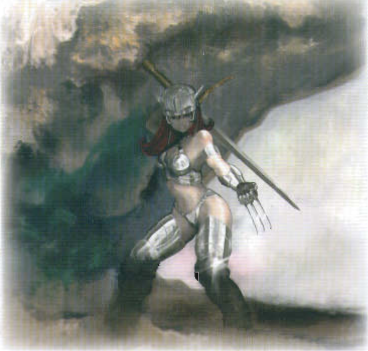
Note: game does not actually allow for a chain mail bikini; if your legs are covered, your torso also is.
Next time: combat! ...Or the start of it. Remember, this is someone's D&D game with added anime and 'sperging. It won't be simple